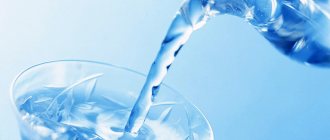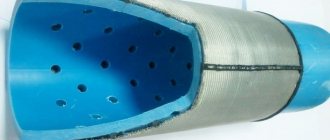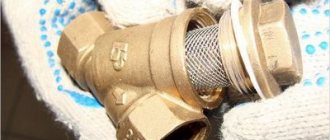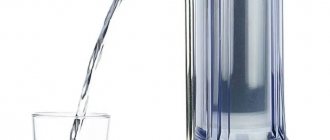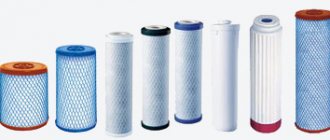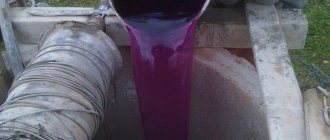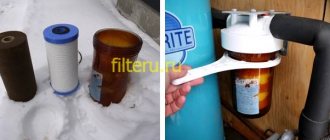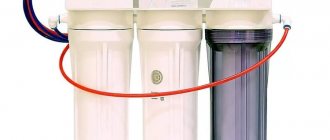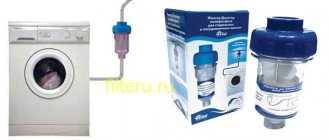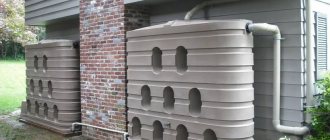What filters are used to purify water from wells?
Purifying well water is a serious operation. The health of people living in a country house or dacha, where the main source of water supply is a well, depends on the quality of water resources. For water purification in such cases, a set of filters is installed:
- Coarse filter. It is used for pre-filtration. Screen out coarse pollutants: dissolved clay, rust, sand
- Aeration column. They use containers of 30-50 liters into which air is pumped. Iron, manganese and some other contaminants, when combined with oxygen, are oxidized and then filtered out. Aeration removes gases: methane, hydrogen sulfide, ammonia
- Reagent or non-reagent deferrizers. Water passes through the backfill layers. The catalysts or reagents they contain oxidize divalent metals that were not purified by aeration.
- Softener. “Hard” salts are eliminated primarily by ion exchange. Granular ion exchange resin effectively captures hardness and simultaneously removes excess ferrum. Ion exchange filter - highly efficient equipment for water treatment
- Disinfection filter. The most commonly used method is ultraviolet irradiation. Ultraviolet light kills dangerous microscopic organisms
- Fine cleaning. Fine particles are screened out
Water purification from a well is usually completed at the fine filtration stage, but sometimes a reverse osmosis system is used at the last stage of purification.
Using this device, the liquid is purified to crystal, almost distilled purity. This water is not recommended for drinking. It contains few minerals. Suitable for home use only if you constantly drink mineral water after installing the osmotic filter. Household appliances “like” water purified by osmosis. She is very soft.
Preparatory work
The highest degree of water purification is provided by a reverse osmosis installation.
Before you begin to study the sequence of installing filters, you need to complete all the preparatory measures. They start by assembling some parts of the purification system, which are the plumbing connection. This is a small shut-off valve and tee. This work is carried out in two stages - assembly and installation of the unit on the water supply system.
- Assembling the working unit - inserts.
This stage does not cause difficulties, since it is only necessary to correctly and tightly connect the tee to the tap. One edge of such a tee is equipped with an internal thread of 0.5 inches, the second is external with 0.5 inches, and the third, intended for connection to the shut-off valve, has an internal thread with a smaller diameter. Fum tape or tow is tightly wound around the tap, after which this part is screwed into the tee and fixed well with a wrench. Now is the time to turn off the water supply and begin installing the prepared tap. Insertion of a tee and tap for supplying water to the filter - The next stage is more troublesome, but its implementation does not require special knowledge and skills. First of all, you need to find where the cold water pipe is located. It is equipped with a shut-off valve and needs to be twisted. The prepared working unit is mounted on the cold water pipe. Particular attention is paid to sealing the seams, otherwise the possibility of leaks cannot be ruled out.
After installation, it is recommended to check the functionality of the working node. To do this, place the small filter faucet in the closed position and turn on the water supply. If no leaks appear, you can begin installing the water purification filter.
Chemical analysis
At Profwater we analyze water from wells, city water supply systems, and wells. You can collect samples yourself, following our advice, or trust our employee. For laboratory tests you need 1-1.5 liters of liquid. Before filling the bottle, let the stream flow from the tap for 20 minutes, only after that fill it into the prepared container. For advanced analysis, 2-3 such bottles are needed. Containers from sweet or alcoholic drinks should not be taken for sample collection.
Water is tested according to 6 parameters:
- Liquid turbidity
- Mineral content
- Chroma
- Con soleil
- Iron
- PMO
These indicators are sufficient for selecting treatment equipment individually for the well. Based on the results of the chemical analysis, we will design and assemble a filtration installation that is effective in your situation. We deliver and install equipment in a private home, and carry out commissioning work.
Basic operating rules
- It is important to promptly change cartridges in filters that have exhausted their service life. Old consumables not only reduce the overall performance of the filter, but also pose a serious threat to human health. Dirt accumulates on their surface, which gradually increases, breaks into components and enters the human body.
- Water filters should be used constantly. If for some reason it has been offline for a week or more, it is imperative to clean it and replace the cartridges. During downtime, the contaminants that have accumulated on the surface turn into an excellent breeding ground for many microorganisms.
- An ordinary jug cannot completely purify water. Even if it contains cartridges with several active substances, they still cannot completely cope with all impurities. Therefore, it is important to think about installing other equipment for hard water, if this is really necessary.
Of course, these are general recommendations. You can find out about all operating conditions in the detailed instructions that come with the equipment, or ask for help from a consultant. A full range of reliable water filters of various types from the world's leading manufacturers (Atoll, BWT, Omoikiri, Aquaphor, Geyser, Barrier) at a competitive price is presented in the MoykiPlus online store. Delivery of goods is carried out in Moscow by courier and to other cities of the Russian Federation by postal services. For purchases over 8,000 rubles, delivery is free. All products sold are guaranteed. You can place an order by phone with the help of a manager or through the shopping cart on the website.
Follow our promotions, which will allow you to purchase equipment at an even better price.
Water treatment equipment and technologies
Aeration
The essence of the method is to saturate contaminated water with oxygen. As a result, 2-valent dissolved metals are oxidized, precipitated, and filtered out. The released hydrogen sulfide, along with other gases, is removed through an air vent. The technique is effective at elevated temperatures and improves the organoleptic characteristics of water.
Aeration is a popular method of purifying water from a well due to the high performance of the equipment and the lack of replaceable filter materials. The aeration column does not take up much space in the house. The device is environmentally friendly and does not require the use of chemical reagents hazardous to nature and humans.
Reagents
Reagent materials in bed filters take on the function of oxidizing agents. With the help of these substances, II-valent iron is converted into III-valent iron. Loses its solubility property. The resulting oxides are filtered through a mechanical filter. II-valent aluminum and manganese are removed in the same way.
The most commonly used reagents are:
- Chlorine (sodium hypochlorite)
- Ozone
- Potassium permanganate (potassium permanganate)
The disadvantage of the technology is the need for precise dosage of the reagent. In large quantities, potassium permanganate and chlorine are toxic and dangerous to people and the environment. Reagent loads remove metals with a saturation of up to 15 mg per liter and remove hydrogen sulfide.
Ion exchange
Ion exchange filters are excellent water purifiers. Removes ferrum up to 30 mg per liter and effectively softens. Essentially, they are universal, do not require the use of hazardous reagents, and are inexpensive. The difference in market value with other softeners is 25-50%.
They act based on the ion exchange properties of some materials. An ion- and cation-exchange resin is used as a filter media. This substance is capable of drawing pollutant ions from a liquid medium, releasing its own ions, loosely attached to the molecular lattice. Thus, hardness salts and metal compounds remain in the filter. Purified soft water enters the home pipeline.
Catalysts
In addition to reagents, catalytic loadings are used:
- Sorbent AC, MC
- Birm
- Pyrolox
Sorbents are more effective if you mix them according to the formula: half AC + half MC. In mixed form, up to 99% of dissolved iron and up to 96% of manganese are removed. In addition to metals, hydrogen sulfide, fluorine compounds, petroleum products, and phenol are eliminated. The filter material has good dirt holding capacity, does not cake, and is compatible with most oxidizing agents. Long service life. Annual efficiency loss is less than 2%.
Catalytic backfill Burm is a granular filter material of industrial production. Birm granules are lightweight silicon cores coated with silicon dioxide, manganese, and iron. The material filters out “ferrum” well, does not require the cost of chemical reagents, does not wear out, and if its cleaning properties are lost, it is easily restored by backwashing.
Pyrolox is a raw material that has been used in water treatment filters for 75 years. Consists of black granules, 2.8–0.84 mm in size. Efficiency has been proven over decades of use. Made from natural rocks containing manganese dioxide. The material is durable and heavy, requiring a good supply of water when washing. Combined with aeration, ozonation, chlorination.
Hollow fiber
Advanced membrane cleaning technology that filters out the smallest impurities, including bacteria and cysts (microfiltration membrane with pores up to 0.1 microns), and in some cases viruses (ultrafiltration membrane with pores up to 0.01 microns - since viruses are among the smallest of possible impurities).
Yes, hollow fiber is also a membrane: in the filter it can be placed in the form of a roll, as in the case of reverse osmosis, but for convenience and to minimize the occupied space, thin “strings” are made from it, the walls of which consist of super-fine hollow cells, through which and pollutants try to pass along with the flow of water - however, to no avail. This is a guarantee of antibacterial protection - exclusively mechanical, without any chemical additives, which is especially important for families with small children.
Calculation of the performance of the treatment complex
Once the water composition has been determined, the capacity of the future treatment plant is calculated. Competent engineering calculations will provide the house with the necessary volume of water. Water consumption depends on the number of residents and the number of water intake points in the water supply. At these points there are usually washing machines, faucets, showers and other useful household appliances. The presence of swimming pools, baths and other consumers is also taken into account.
Even with the necessary information on hand, it is difficult to calculate water consumption without professional knowledge. We need special formulas, tables, diagrams. The engineering department of our company designs and assembles cleaning systems individually for each home. We use special programs for calculating water consumption. We calculate the required pressure, take into account the resistance of filter materials and other parameters in order to provide your home with enough water for a comfortable life.
Do you need a filtration system at home?
A water purifier is necessary if you cannot drink tap water:
- it is cloudy and smells bad;
- with a taste of iron or rotten eggs;
- strongly reeks of chlorine.
Also, a filtration system is needed if the water pipes are old and rusty , because they are the source of:
- bacteria;
- silt;
- sand;
- gland.
Do you buy bottled water? As an alternative, you can install a water purifier, it will quickly pay for itself. But which model to choose depends on the quality of water and volume of consumption.
Well water quality problems
It is a common belief that the deeper the well, the cleaner the water. the water from the well any purification or filtration . Unfortunately, this is not true. After chemical analysis, the following characteristic pollutants are found in groundwater:
- Hydrogen sulfide and other dissolved gases
- High concentrations of iron and manganese
- Calcium and magnesium salts of hardness
Hydrogen sulfide is a toxic gas that is harmful to health and has a characteristic smell of rotten eggs. The substance is so dangerous that its concentration in drinking water should not exceed 0.003 mg/liter. Symptoms of poisoning are dizziness, nausea, headaches. Aeration columns effectively remove hydrogen sulfide. In them, the water is saturated with oxygen, which displaces all dangerous gases.
Iron enters underground reservoirs from iron-containing rocks. In the absence of oxygen it has a dissolved 2-valent form. For this reason, when raised from the ground, water appears crystal clear. However, if you put it in a white or transparent container to sit for a couple of hours, it will turn yellow or brown depending on the concentration of the substance. According to standards, iron in water should not exceed 0.3 mg per liter. If more, the water from the well needs purification . Excess iron is well removed by filters with ion exchange or catalytic loading in conjunction with an aeration column.
The water hardness indicator depends on the concentration of calcium and magnesium salts. If the content is high, scale forms in the kettle and on the heating elements of washing machines and dishwashers, which ultimately leads to breakdown. Constant consumption of hard drinking water is not beneficial for humans either. Promotes the formation of stones and the accumulation of salts in the organs and tissues of the body. Negatively affects the cardiovascular system. Purifying water from a well to remove hardness is most effective when using ion exchange resins.
This is a reagent-free load that softens water well without the use of powerful chemical reagents that are dangerous to nature and humans.
Where to buy?
water filters from official online or offline stores from manufacturers.
If there is no representative office in your locality, look at the list of distributors with whom the company cooperates.
By purchasing a water purifier from a trusted place, you will protect yourself from being deceived by scammers who pass off fakes as originals.
Attention! When purchasing, pay attention to the integrity of the box, the packaging (check the presence of each part according to the design), and the absence of mechanical damage to the product. Also make sure that the warranty card is filled out and has the seller’s stamp on it.
What kind of water is considered hard?
The main visible sign of hard water is the build-up of layers of scale in the kettle, which become more and more with each boiling. Until they start to flake off in hard pieces. The reason for their formation is the high content of calcium and magnesium salts in water, also known as hardness salts. Based on their concentration, water is divided into:
- Hard - more than 10 mEq/liter
- Medium hardness - from 2 to 10
- Soft - less than 2
According to standards in Russia, hardness of up to 7 mEq/liter is considered normal for water. In European countries this figure is much lower - up to 2.5.
At Profvater you can order filters for purifying water from a well , a well, or a city water supply. We perform a free chemical analysis of water and, based on its results, select the optimal water treatment equipment for your home. We check the filters after installation using another water analysis. We guarantee the quality of water treatment.
Sorption
If a mechanical filter is a sieve, then a sorption filter is a sponge that absorbs impurities dissolved in water. Gas masks work on the same principle - only they extract pollutants not from liquid, but from air. Absorbent materials are called sorbents, the most popular of which is activated carbon.
What does activated mean?
The raw materials (in the case of AQUAPHOR, this is coconut shells) are turned into coal by heating without access to oxygen - this process is called “pyrolysis”. The resulting coal is treated with water steam at a temperature of about 1000°C. The result is a very pure material with excellent sorption properties: the surface area is about 1000–1500 square meters per 1 gram of coal.
One more small detail: not all activated carbon can purify water well. The size of the granules and its origin are also important: birch, and even more so coal, cannot be compared in quality to coconut coal. It activates better, and the resulting surface area is many times greater than what would be expected from other types of coal.
Modern filter mixtures contain not only carbon, but also additional sorbents, which give the materials a synergistic effect. AQUAPHOR uses AQUALEN™ microfiber as such an element: it is not only a “trap” for heavy metals, but also a hydrophilic (“water-loving”) agent that allows the use of the smallest coal granules, which means increasing the area of contact with water and the depth of cleaning.
What filters do we install?
We install filters and water treatment systems in private houses and apartments, cottages, offices, cottages and factories. We will individually design and assemble a filtration system for any source of water supply - well, borehole, central water supply. You can also purchase compact complex filters from Profvater.
We offer a ready-made solution for offices - cabinet filters of various capacities. The main advantage of the device is that one filter removes excess iron, hardness salts, mechanical particles, organic matter and heavy metals from water. This is a device that won't take up much space.
We install water treatment systems for better purification of water from wells , wells, and pipelines. The number of filters they contain depends on the types of pollutants that a chemical analysis of the water from your water supply will show. Water treatment complexes take up quite a lot of space, but last longer and have greater productivity - up to 2 or more m3/hour. For details, contact our consulting engineers at: +7 (495) 215-54-11.
Criterias of choice
When choosing a water filter for your home, you must consider the following number of criteria:
- Purpose - what specific filtering functions the device should perform - rough cleaning, softening, disinfection, etc.
- Installation location: under the sink, on the faucet, etc.
- Dimensions - must correspond to the installation location so that there are no problems during installation and maintenance.
- The operating principle is flow or reverse osmosis.
- Stationary with the possibility of updating filter elements or one-time use.
- Productivity - depends on the volume of flowing water in a given period of time or the number of people living in the house.
- Price.
- Manufacturer.
On a note! The most convenient to use and the best in terms of degree of purification is a stationary osmotic type filter. To extend its service life, it is enough to replace the filter elements in a timely manner. At the same time, the osmotic system purifies water to the greatest extent from various types of polluting factors - mechanical particles, salts, dissolved substances and microorganisms.
The choice of filter is influenced by both the initial and required quality of consumed water Source make-self.net
Comparison table of characteristics
To make your choice easier, we offer you a comparative table of characteristics of the devices described above.
| Model | Productivity, l/min. | Inlet pressure, atm. | Water temperature, °C | Dimensions (WxHxD), cm |
| Atoll S-28 EcoLife | 33,3 | 1.50 — 6 | 1 — 42 | 35x110x51 |
| Aquaphor WaterBoss 400 | 30 | 1.40 — 8 | 4 — 50 | 29.2×54.6×47 |
| Viessmann Aquahome 17-N | 32 | 1.40 — 8 | 1 — 40 | 30.2x82.2x48 |
| Fibos ХВ 3000 l/hour | 50 | 1.2 — 4 | 1 — 40 | 18x34x18 |
| Geyser Aquachief 1054 | 25 | 1.4 — 7 | 1 — 40 | 10x54 (column) |
| RAIFIL CSII 1035 | 40 | 1.5 — 3 | up to 38 | 5x118.8x60 |
| New Water B120 | 13 | 1.4 — 5.5 | 5 — 35 | 9x18x9 |
